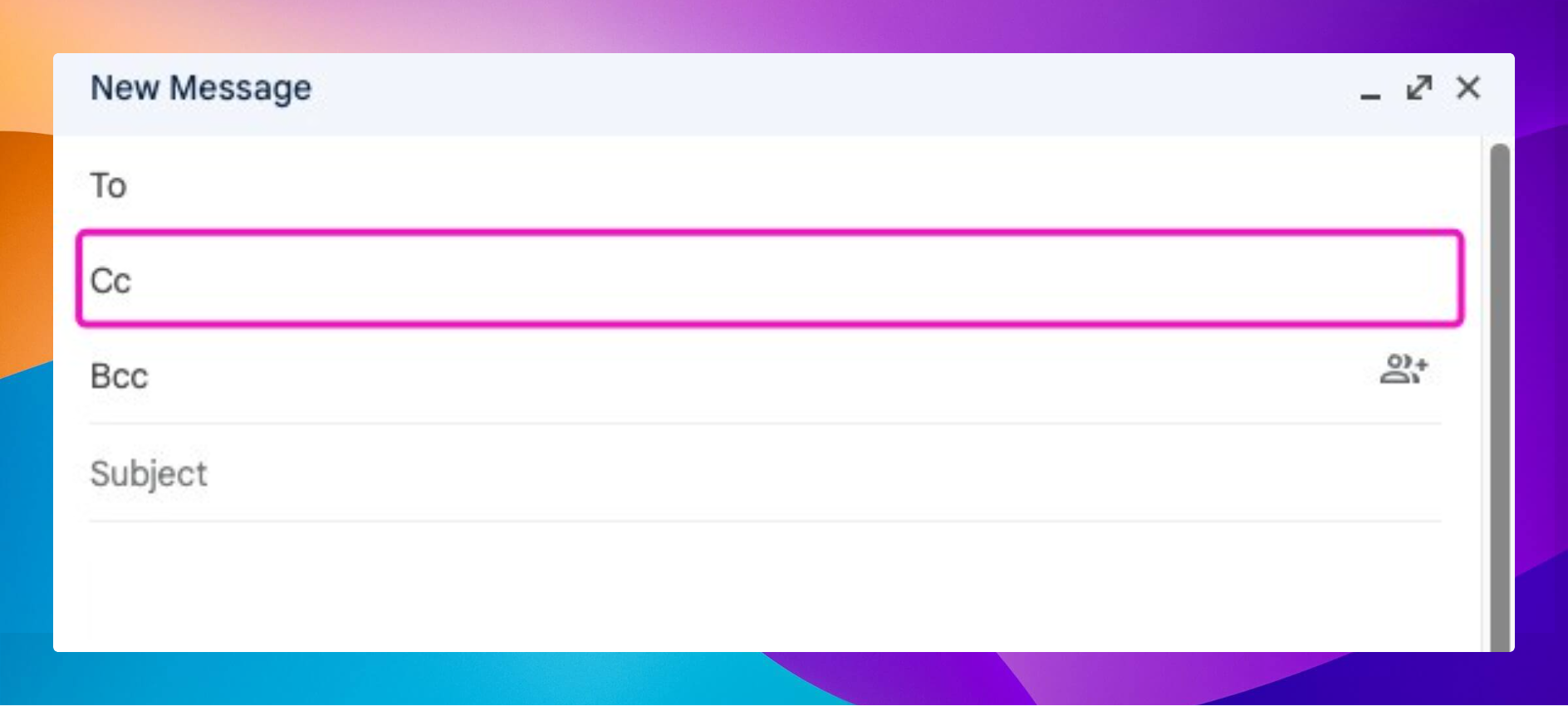What do CC and BCC mean in emails?
Email is a key tool for both personal and professional communication. When composing an email, you might notice the “CC” and “BCC” fields. These fields serve different purposes and are important to understand for effective communication and email etiquette.
The “BCC” field is usually found below the “CC” field in most email clients. It allows you to add recipients without revealing their addresses to others. Knowing how and when to use these fields helps ensure clear and appropriate communication.
This article will explain what CC and BCC mean in emails, highlight their differences, and provide best practices for using them. While CC recipients are visible to everyone, BCC recipients remain hidden, making the choice between them crucial for transparency and privacy.
Ready to enhance your email management? Try Gmelius!
What does CC mean in email?

CC stands for Carbon Copy.
The term comes from the era of typewriters, where carbon paper was used to make duplicates. In email, the CC field lets you send a copy of your email to additional recipients. Everyone listed in the CC field gets the email and can see who else has been CC'd.
How CC works in emails
When you include an email address in the CC field, the recipient gets a copy of the email. Unlike those in the “To” field, CC recipients aren't the primary audience but are included to stay informed. The main feature of CC is transparency—everyone in the CC field can see all other recipients. Understanding how to use both CC and BCC is essential: CC is for transparency, while BCC is for privacy.
CC meaning and common cases
When you CC someone, you are essentially saying, "I'm keeping you informed, but no action is required on your part." Some typical scenarios include:
- Keeping Stakeholders Informed: CC your manager or team leader on relevant emails to keep them updated on project progress.
- Maintaining Transparency: Use CC to keep everyone on the same page for project updates or group decisions.
- Professional Etiquette: In formal settings, CC helps document communication with multiple parties.
What Does BCC Mean in Email?

BCC stands for Blind Carbon Copy.
Like CC, it comes from the carbon copy concept but focuses on privacy.
How BCC works in emails
When you use the BCC field to add recipients, they receive the email just like those in the “To” and “CC” fields. However, the key difference is that recipients in the BCC field are hidden from everyone else.
The BCC function is beneficial for maintaining recipient privacy in group emails and preventing reply-all clutter. Other recipients cannot see who is on the BCC list, which makes BCC a powerful tool for maintaining privacy in email communication. To ensure the email can be sent when using BCC, it is necessary to include an email address in the 'To' field; using one's own email address is a common workaround.
BCC meaning and common use cases
BCC is useful for keeping recipients’ details private or preventing unwanted “Reply All” situations. However, misuse can lead to transparency issues or misunderstandings if a BCC'd person replies to all. Common scenarios for BCC include:
- Protecting Privacy: Use BCC in mass emails, like newsletters, to keep email addresses confidential.
- Preventing Reply-All Chains: In large groups, BCC prevents a flood of replies.
- Email Marketing: BCC is commonly used to protect recipient lists in marketing emails.
CC vs. BCC – Key Differences
Knowing the differences between CC and BCC is important for proper email use. Here’s a breakdown:
Visibility
CC: Recipients can see all others copied on the email.
BCC: Recipients are hidden from each other, ensuring privacy.
Purpose
CC: For transparency and keeping others informed.
BCC: For privacy and avoiding reply-all chains.
Response expectations
CC: Recipients might feel expected to respond, especially in professional contexts.
BCC: Recipients are generally not expected to reply.
Email etiquette: When to use CC vs. BCC
CC: Use when you want to keep someone informed without requiring a response. For example, updating stakeholders who don’t need to act on the information.
BCC: Use when sending emails to large groups to protect privacy, like in a mass email or to avoid unnecessary replies.
Here’s a quick comparison:
Best practices for using CC and BCC in emails

Use CC:
- When you want everyone to know who received the email.
- To keep a third party informed without involving them in the conversation.
Use BCC:
- When privacy is key.
- To avoid clutter from unnecessary replies in group emails.
⚠️ Avoiding common pitfalls ⚠️
- Overusing CC: CC’ing too many people can lead to email overload and frustration.
- Accidental Exposure of Emails: Using CC instead of BCC in mass emails can expose recipients’ emails, leading to privacy concerns. BCC recipients cannot see the names or addresses of other BCC recipients.
💡 Email etiquette tips 💡
- Be Selective: Only include those who need the information.
- Clear Subject Lines: Make the email’s purpose clear from the start.
- Keep Emails Concise: Short emails help prevent missed information.
Benefits of using CC and BCC correctly
Using CC and BCC properly can offer several benefits:
- Improved Communication: Keeps everyone informed without overwhelming them.
- Enhanced Productivity: Reduces unnecessary replies and email management time.
- Privacy and Security: Protects sensitive information from exposure.
Real-World Scenarios
Professional Example – CC: Sending a project update to your team and CC’ing your manager to keep them informed.
Subject: Project X Update
CC: [Manager's Email]
Hi Team,
Here’s a quick update on Project X…
Best,
[Your Name]
Professional Example – BCC: Sending a client newsletter to a large group and using BCC to keep email addresses private. Utilizing BCC in marketing emails is crucial for maintaining privacy while distributing emails to multiple recipients. This is particularly important when sending newsletters, brand updates, and promotions. Proper use of BCC ensures email etiquette is followed and helps avoid potential legal implications related to handling recipients' email addresses.
Subject: Monthly Newsletter – September Edition
BCC: [Recipient List]
Hi Everyone,
We are excited to share the latest updates…
Cheers,
[Your Name]
What are Your Options Instead of CC and BCC in Email?
While CC and BCC offer different ways to add people to an email, it’s easy to overload your contacts or colleagues and to forget adding them to the loop when needed.
A great alternative to the copy carbon field in email is introduced by a new kind of software solutions, such as the email collaboration platform offered by Gmelius. Gmelius makes it possible to automatically share with other people (e.g., team members) conversations sent to a specific email address, emails added to a specific Gmail label or a single email thread.
You can share the conversation any time after it has already been sent, making it a more flexible choice than legacy email carbon copies. Besides, you can control at any point in time with whom the conversation is actually shared.

A Few Other Frequently Asked Questions About CC and BCC
What’s the difference between CC and BCC in Gmail?
CC (Carbon Copy) lets everyone see who else received the email. BCC (Blind Carbon Copy) hides recipients from each other, useful when emailing a group without exposing addresses.
When should you CC someone versus forwarding an email?
Use CC to keep someone in the loop during the conversation. Forward an email if you're sharing it after the fact or want to add commentary privately.
Why does CC matter in professional email communication?
CC helps ensure transparency, accountability, and shared awareness, especially in team settings. But misuse (like over-CCing) can lead to noise and confusion.
Can you CC multiple people without spamming them?
Yes, but make sure each recipient has a clear reason to be looped in. Add context in the message to avoid confusion and reduce the chance of unnecessary replies.
How do shared inbox tools like Gmelius enhance CC management?
Gmelius lets teams view and collaborate on emails without needing to CC colleagues constantly. It reduces internal CC clutter by centralizing visibility and responsibility.
Conclusion
Understanding CC and BCC is crucial for effective email communication. By using them correctly, you can improve email collaboration, protect privacy, and streamline email management. Always follow best practices to avoid pitfalls and ensure smooth communication.
Consider using tools like Gmelius to go further legacy email carbon copies, and start collaborating in a safer, better, and simpler way. Start a free trial now.


